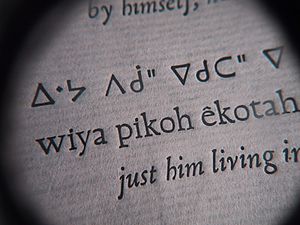Western Cree syllabics facts for kids
Quick facts for kids Western Cree syllabics |
|
|---|---|
 |
|
| Type | Abugida |
| Spoken languages | Plains Cree, Woods Cree, western dialects of Swampy Cree |
| Time period | 1840s-present |
| Parent systems |
Devanagari, Pitman Shorthand (disputed)
|
| Child systems | Eastern Cree, Blackfoot, Slavey, Dogrib, Beaver, Sayisi (Chipewyan), Carrier |
| Unicode range | Unified Canadian Aboriginal Syllabics, U+1400–167F (chart) |
| ISO 15924 | Cans |
| Note: This page may contain IPA phonetic symbols in Unicode. | |
Western Cree syllabics is a special way of writing used for different types of the Cree language. It's like an alphabet, but each symbol stands for a whole syllable (a sound like "ba" or "ko") instead of just one letter.
This writing system is used for Plains Cree, Woods Cree, and some western parts of Swampy Cree. You'll find it in Canada, west of the border between Manitoba and Ontario. A few Cree speakers in the United States also use it sometimes.
Sounds of Western Cree Syllabics
Every language has its own set of sounds, called phonemes. Western Cree syllabics only use the characters needed for the sounds in these western Cree languages.
The sounds in Western Cree are similar to English. For example, the letter 'c' sounds like "ts" (like in "cats").
Cree languages have different vowel sounds. Some vowels are short, and some are long. Long vowels are often written with a special mark above them, like a hat (circumflex) or a line (macron). For example, ê is always a long vowel and doesn't have a short version.
How Western Cree Syllabics Work

Cree syllabics use different shapes for consonant sounds. Then, they change the way these shapes face to show which vowel sound comes after the consonant. It's a clever system! You can learn more about how this works in general by looking at the Canadian Aboriginal syllabics article.
Here's a table showing the main Western Cree syllabic characters:
| Initial | Vowels | Final | ||||||
|---|---|---|---|---|---|---|---|---|
| ê | i | o | a | î | ô | â | ||
| ᐁ | ᐃ | ᐅ | ᐊ | ᐄ | ᐆ | ᐋ | ||
| p | ᐯ | ᐱ | ᐳ | ᐸ | ᐲ | ᐴ | ᐹ | ᑊ |
| t | ᑌ | ᑎ | ᑐ | ᑕ | ᑏ | ᑑ | ᑖ | ᐟ |
| k | ᑫ | ᑭ | ᑯ | ᑲ | ᑮ | ᑰ | ᑳ | ᐠ |
| c | ᒉ | ᒋ | ᒍ | ᒐ | ᒌ | ᒎ | ᒑ | ᐨ |
| m | ᒣ | ᒥ | ᒧ | ᒪ | ᒦ | ᒨ | ᒫ | ᒼ |
| n | ᓀ | ᓂ | ᓄ | ᓇ | ᓃ | ᓅ | ᓈ | ᐣ |
| s | ᓭ | ᓯ | ᓱ | ᓴ | ᓰ | ᓲ | ᓵ | ᐢ |
| y | ᔦ | ᔨ | ᔪ | ᔭ | ᔩ | ᔫ | ᔮ | ᕀ (ᐝ) |
| th | ᖧ | ᖨ | ᖪ | ᖬ | ᖩ | ᖫ | ᖭ | ᙾ |
| w | ᐍ | ᐏ | ᐓ | ᐘ | ᐑ | ᐕ | ᐚ | ᐤ |
| h | ᐦᐁ | ᐦᐃ | ᐦᐅ | ᐦᐊ | ᐦᐄ | ᐦᐆ | ᐦᐋ | ᐦ |
| hk | ᕽ | |||||||
| l | ᓬ | |||||||
| r | ᕒ | |||||||
Important Notes:
| Initial | Vowels | Final | |||
|---|---|---|---|---|---|
| ê | i | o | a | ||
| r | ᖊ | ᖋ | ᖌ | ᖍ | ᙆ |
| l | ᕃ | ᕆ | ᕊ | ᕍ | ᔆ |
The "th" series of characters looks a lot like the "y" series. This is because the "th" sound in Woods Cree is similar to the "y" sound in Plains Cree. Cree writers changed the "y" characters slightly to make the "th" ones.
To show the "w" sound, a small dot is placed after the syllable. For example, "wa" is written as ᐘ. This is different from Eastern Cree syllabics, where the dot goes before the syllable. This is one of the main differences between Eastern and Western Cree syllabics.
Sometimes, the dot that shows a long vowel is left out in real texts. This happens if the meaning is clear from the rest of the sentence. So, long and short vowels might look the same. You have to use the context to figure out which one it is.
Western Cree writers also use a special character, ᙮, to mark the end of a sentence. This helps avoid confusing it with the dot used for the "w" sound.
Here's an example of Plains Cree written using Western syllabics:
ᑳᒫᒋᐲᑭᐢᒁᑎᑯᐟ ᐆᐦᐃ ᐅᐢᑳᔭ ᐁᓀᐦᐃᔭᐍᔨᐟ᙮ ᒫᑲ ᓇᒨᔭ ᓂᓯᑐᐦᑕᐍᐤ ᐊᐘ ᐅᐢᑭᓂᑮᐢ ᑖᓂᓯ ᐁᐃᑘᔨᐟ ᐋᑕ ᐏᐢᑕ ᐁᓀᐦᐃᔭᐍᐟ᙮
kâ-mâci-pîkiskwâtikot ôhi oskâya ê-nêhiyawêyit. mâka namôya nisitohtawêw awa oskinikîs tânisi ê-itwêyit âta wîsta ê-nêhiyawêt.
This means:
- The young people then began to speak in the language of his ancestors – Nêhiyawêwin (the Plains Cree language). Unfortunately, the young man could not understand what they were saying, even though he was from the same nation; Nêhiyaw (the Plains Cree people).

